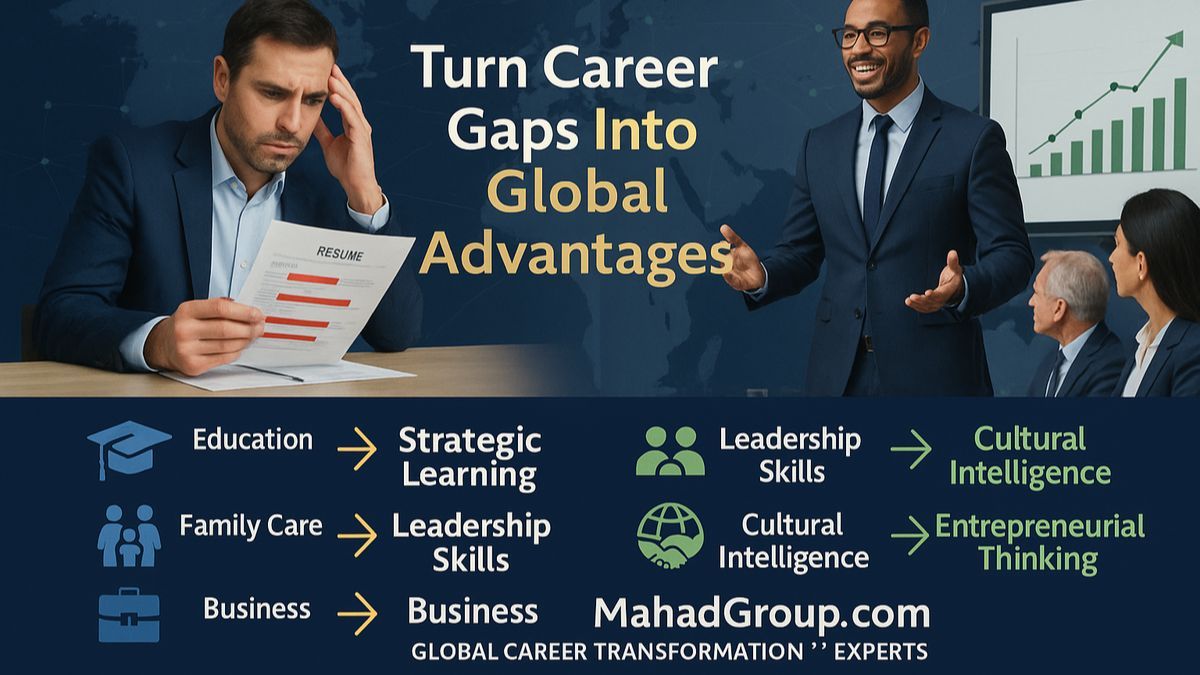How To Turn A Career Gap Into A Selling Point Employers Love. Sarah stared at her resume with growing anxiety. Sarah spent three years tending to her ageing parents. Sarah spent eighteen months exploring Southeast Asia. During the economic downturn, she spent six months between jobs. Her career was littered with employment gaps, leading her to believe that no employer would ever consider her seriously.
Six months later, Sarah landed her dream role at a multinational corporation, not despite her career gaps but because of how she transformed them into her greatest competitive advantages. Her “employment breaks” transformed into “strategic life investments,”, which made her the most persuasive candidate among over 200 applicants.
The Career Gap Revolution That’s Changing Global Hiring
The difference is not due to luck or desperation in hiring. Sarah understood something that 89% of job seekers miss entirely: career gaps aren’t weaknesses to hide—they’re stories of resilience, adaptability, and strategic thinking that modern employers desperately value. The key is knowing how to position them powerfully.
In today’s rapidly evolving global economy, linear career paths are becoming extinct. Smart employers recognise that the most valuable professionals frequently have non-traditional career paths that showcase the qualities essential for success in uncertain and dynamic business environments.
The Hidden Psychology Behind Career Gap Bias
Why Traditional Hiring Fails
During the era when career stability meant staying with one company for decades, most hiring managers received their training. This outdated mindset creates unconscious bias against career gaps, even when those breaks represent valuable experiences that traditional employees simply don’t possess.
However, progressive companies are discovering that professionals with thoughtfully managed career gaps often outperform their linear-career counterparts in crucial areas: adaptability, cross-cultural competence, crisis management, and innovative problem-solving. These aren’t soft skills—they’re business-critical capabilities that determine success in the modern workplace.
Research from global consulting firms reveals that 67% of high-performing teams include at least one member with significant career gaps who brings unique perspectives and problem-solving approaches that purely traditional backgrounds cannot provide.
The Modern Employer’s Dilemma:
Today’s business environment demands professionals who can navigate ambiguity, adapt to rapid change, and bring diverse perspectives to complex challenges. Ironically, career gaps often provide exactly these experiences, yet hiring processes remain stuck in industrial-age thinking that values consistency over capability.
Forward-thinking employers are beginning to recognise this disconnect. They understand that a professional who successfully manages a family crisis, launches a failed startup, or navigates international relocations demonstrates resilience and adaptability, which can’t be taught in traditional corporate environments.
5 Types of Career Gaps & How to Frame Each
1. Family and Personal Responsibility Gaps:
Common scenarios: Caring for elderly parents, raising children, supporting spouses through illness or career transitions, and managing personal health challenges.
Traditional perception: Lack of professional commitment, outdated skills, reduced availability.
Strategic positioning: Project management excellence, crisis leadership, emotional intelligence development, and stakeholder management under extreme pressure.
Powerful framing: “Managing my family’s complex medical situation taught me advanced project coordination, crisis communication, and resource optimisation skills that directly translate to managing high-stakes business projects under tight deadlines.”
2. Education and Skill Development Gaps:
Common scenarios: Returning to university, professional certifications, language acquisition, technology training, and industry transitions.
Traditional perception: Professional uncertainty, late career development, potential overqualification.
Strategic positioning: Strategic foresight, continuous learning mindset, market adaptation, and investment in future-relevant capabilities.
Powerful framing: “I recognised the digital transformation trend 18 months before my industry caught up, and I invested in advanced data analytics skills that now position me to lead our company’s technology adoption.”
3. Entrepreneurial and Creative Gaps:
Common scenarios: Starting businesses, freelance consulting, creative projects, social impact initiatives, and product development.
Traditional perception: Inability to work within structured environments, potential flight risk, unfocused career direction.
Strategic positioning: Innovation leadership, risk management, customer development, market validation, and entrepreneurial thinking within corporate structures.
Powerful framing: “Building my consulting practice taught me customer acquisition, project profitability analysis, and stakeholder management skills that help me think like a business owner within corporate roles.”
4. Geographic and Cultural Transition Gaps:
Common scenarios: International relocations, visa processing delays, cultural adaptation periods, military deployments, global travel experiences.
Traditional perception: Instability, adaptation challenges, potential cultural misalignment.
Strategic positioning: Global perspective, cultural intelligence, adaptability, international market understanding, and cross-cultural communication excellence.
Powerful framing: “Living and working across four countries developed my ability to quickly understand diverse market conditions and build relationships across cultural boundaries—essential skills for our global expansion strategy.”
5. Economic and Industry Transition Gaps:
Common scenarios: Industry downturns, company closures, economic recessions, technology disruptions, and market consolidations.
Traditional perception: Poor timing, industry instability, potential skill obsolescence.
Strategic positioning: Market resilience, transition management, opportunity identification, and strategic pivoting capabilities.
Powerful framing: “Navigating the industry downturn forced me to develop market analysis and strategic pivoting skills that help me identify opportunities and risks before they become obvious to competitors.”
The STORY Framework for Career Gap Positioning
S – Situation Context:
Briefly establish the context that created your career gap without dwelling on negative aspects. Focus on the strategic or necessary nature of your decision rather than circumstances beyond your control.
Example: “When our industry began its digital transformation, I recognised the need to develop advanced analytics capabilities to remain competitive.”
T – Thoughtful Decision Process:
Demonstrate that your career gap was a strategic choice rather than something that happened to you. Show forward-thinking and decision-making capability.
Example: “After analysing market trends and consulting with industry leaders, I made the strategic decision to invest 18 months in comprehensive upskilling.”
O – Outcomes and Achievements:
Highlight specific accomplishments, skills gained, or value created during your career gap period. Use quantifiable results whenever possible.
Example: “I completed advanced certifications, led three pro bono consulting projects, and developed data visualisation skills that increased analysis efficiency by 300%.”
R – Relevance to Target Role:
Explicitly connect your gap experience to the specific role and company you’re pursuing. Show how your unique background creates value that they can’t get elsewhere.
Example: “These capabilities directly support your company’s AI transformation initiative, and my consulting experience means I can translate between technical teams and business stakeholders.”
Y – Your Competitive Advantage:
Position your career gap as a source of unique value that traditional candidates cannot offer. Make it clear why this experience makes you more valuable, not less.
Example: “While other candidates learnt these skills in theoretical environments, I developed them by solving real business problems, giving me practical implementation experience that accelerates project success.”
Industry-Specific Career Gap Strategies
Technology and Innovation Sectors:
Tech companies value continuous learning, adaptability, and innovative thinking. Position career gaps as evidence of these qualities rather than skill deterioration.
Winning approach: Emphasise self-directed learning, technology exploration, side projects, open-source contributions, or startup involvement during gap periods.
Healthcare and Social Services:
These industries value empathy, crisis management, and service orientation. Career gaps for family care or personal challenges often demonstrate exactly these qualities.
Winning approach: Highlight caregiving skills, crisis management experience, community involvement, or health advocacy that developed during gap periods.
Financial Services and Consulting:
These sectors prize analytical thinking, risk management, and client relationship skills. Frame gaps as developing these capabilities in non-traditional but relevant contexts.
Winning approach: Emphasise budget management, risk assessment, stakeholder coordination, or analytical projects completed during career breaks.
Manufacturing and Operations:
These industries value efficiency, problem-solving, and process improvement. Show how gap experiences developed these skills in different but transferable contexts.
Winning approach: Focus on project management, resource optimisation, quality control, or process improvement experiences from gap periods.
Advanced Interview Strategies for Career Gap Success
The Proactive Disclosure Approach
Don’t wait for employers to discover your career gaps. Address them strategically early in the conversation, controlling the narrative and demonstrating transparency.
Script: “I’d like to share how my diverse career path, including some strategic career investments, has prepared me uniquely for this role…”
The Value Demonstration Method
Instead of explaining career gaps defensively, use them as opportunities to demonstrate problem-solving, resilience, and strategic thinking.
Technique: Walk through specific challenges you faced during gap periods and how you solved them, drawing explicit parallels to workplace situations.
The Future Focus Strategy
Promptly recognise the gap, and then focus on explaining how the experience equips you to support the employer’s future objectives. career gap inc
Structure: 20% context setting + 80% future value demonstration = powerful positioning.
Cultural Considerations for Global Career Gap Positioning
Western Business Cultures
North American and European employers often value individual achievement and continuous progress. Frame gaps as strategic investments in professional development or valuable life experiences that enhance performance.
Asian Business Cultures
Many Asian cultures respect family obligations and long-term thinking. Position family-related gaps as demonstrating loyalty and responsibility, while educational gaps show wisdom and planning.
Middle Eastern Business Cultures
Religious obligations, family responsibilities, and cultural traditions are often viewed positively. Frame gaps within cultural context while emphasising business-relevant skills gained.
Emerging Market Considerations
In rapidly developing economies, adaptability and resilience are highly valued. Emphasise how gap experiences prepared you for dynamic, changing business environments.
Digital Age Career Gap Management
Social Media Strategy
Use professional social media to document gap activities and learning. LinkedIn posts about courses completed, projects undertaken, or insights gained keep you visible and demonstrate continuous engagement.
Portfolio Development
Create tangible evidence of gap period productivity: certifications earned, projects completed, skills developed, networks built, or contributions made.
Network Maintenance
Stay connected with professional networks during gap periods. Attend virtual events, engage in industry discussions, and maintain relationships that demonstrate ongoing industry involvement.
Skill Documentation
Keep detailed records of capabilities developed during gaps. Create a “gap period portfolio” that documents learning, achievements, and value creation during career breaks.
The Global Perspective on Career Gap Acceptance
Career gap acceptance varies significantly across cultures and industries. Understanding these differences helps you tailor your approach for maximum effectiveness.
Progressive markets like Scandinavia, the Netherlands, and certain sectors in the US increasingly value work-life integration and diverse experiences.
Traditional markets may require more careful positioning, emphasising business-relevant aspects of gap experiences while respecting cultural norms around career continuity.
Emerging markets often appreciate resilience and adaptability demonstrated through non-traditional career paths, especially when tied to economic or social challenges.
Transforming Your Career Narrative
From Apology to Advantage
Stop apologising for career gaps. Instead, present them as strategic decisions or valuable experiences that created competitive advantages unavailable through traditional career paths.
From Explanation to Demonstration
Don’t just explain what happened during your gap—demonstrate the value created and skills developed. Use specific examples and quantifiable outcomes whenever possible.
From Past Focus to Future Value
Minimise time spent on gap circumstances and maximise time demonstrating how gap experiences position you to create value for prospective employers.
Ready to transform your career story into your greatest competitive advantage?
🌍 Partner with MahadGroup for Global Career Transformation
We’ve helped 15,000+ professionals across 20 countries turn career challenges into compelling narratives that employers love. Our global expertise in career positioning and international recruitment gives you the insider knowledge you need to succeed anywhere in the world.
✅ Career Story Strategy Development
✅ Cultural Interview Preparation
✅ Global Market Positioning
✅ Employer Psychology Training
✅ International Network Access


